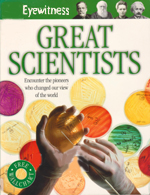|
Great Scientists
Jacqueline Fortey
 2007 Dorling Kindersley
2007 Dorling Kindersley
ISBN 978-1-40537-323-4
72 pages. Soft Cover.
Purchasing Details.
My Comments on This Book
This beatuifully illustrated book contains two pages on 31 of the most noted scientists, from Archimedes to Wegener.
The thumbnails on each are one of the nicest I have seen.
Rutherford is one (p44-5). It is accurate apart from one hoary old story common to almost all books on Rutherford, the fact that
what we today call the Geiger tube was developed by Rutherford with Geiger's assistance and in its day was called the Rutherford-Geiger tube.
One or two further points aren't necessarily wrong but give the wrong impression.
There is no shortage of things Rutherford accomplished so it is surprising space is used for two things he had nothing to do with,
JJ Thomson's discovery of the electron and nuclear power (illustrating Sellafield). For example, Rutherford's dating the age of the earth
would be noteworthy.
Errors Noted.
p 44 "1894 Graduates from Canterbury College, Christchurch." Ruthered sat his final exams in 1892 (BA), 1893 (MA with double first class
honours in mathematics and physics) and 1894 (BSc in chemistry and geology). In the southern hemisphere the academic year starts in Fall (March)
and final exams are in Spring (November). (The papers were shipped to England for marking by the English examiners after the exams,
the results telegraphed back in the last week in February to allow for enrolment, and confirmed when the marked papers arrived back
in New Zealand by fast steamer two months later. So graduation ceremonies are held in August, the year after the exams were sat.
p 44 "1919 Becomes director of Cavendish Laboratory. Carries out the first artificial induced nuclear reaction."
No, he did that at Manchester. Also I wouldn't use "artificial" as he used naturaly ocurring alpha particles from radium C. The first "artificial"
splitting the atom was by Walton and Cockcroft who used protons accelerated in a particle accelerator.
p45 The Rutherford-Geiger tube was developed by Rutherford, with the assistance of Geiger, as he needed a device for detecting individual
alpha particles. Geiger and Muller later modified this device to work better for betas but the modern GM tube is the original R-G tube.
Rutherford had his fame and didn't need more.
Reviews
Not known at this stage.
back to top
|

